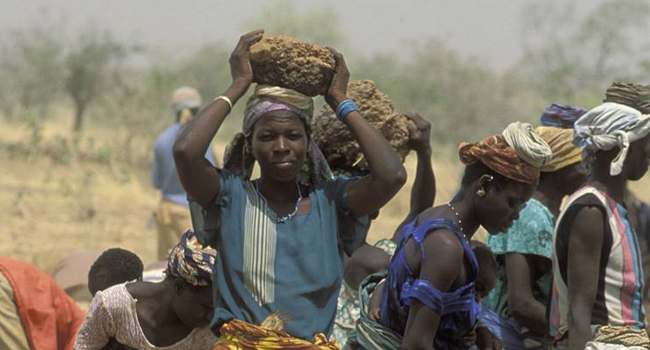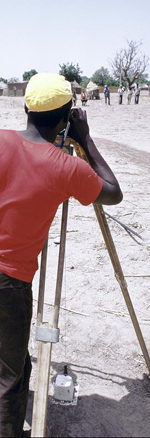
A landlocked country in sub-Saharan Africa essentially reliant on agriculture, Burkina Faso has been considerably affected by the adverse impacts of climate change over the last 20 years. The country has experienced severe rain decrease caused by climate change, which in turn has resulted in a decrease in water resources and a severe degradation of and decrease in pasture land. Thus, four key sectors were identified as being the most vulnerable to climate change: agriculture, water resources, livestock and forests/biodiversity. The most vulnerable populations are to be found among poor rural communities, notably women, young people and small-scale farmers.

Timelines of the NAPA preparation process in Burkina Faso
| Funding for the preparation of the NAPA approved by the GEF |
July 2003 |
| GEF agency approval date |
April 2004 |
| NAPA preparation start |
September 2005 |
| Submission of the NAPA to the UNFCCC |
December 2007 |
NAPA projects under implementation
Burkina Faso selected 12 priority activities and, in order to address a number of issues in its first project, the country decided to adopt a concerted programmatic approach involving three components, one of which was financed through the LDCF, with the other two adaptation initiatives financed by other entities. Following this approach, the programme is composed of the following three components:
- Strengthening of national capacities: funded by the Danish International Development Agency (DANIDA) and the International Union for Conservation of Nature (IUCN);
- Strategic planning: funded by UNDP/Government of Japan;
- Six climate change adaptation pilot projects: funded by the LDCF.
The component funded by the LDCF is of a short-term nature and addresses immediate and urgent needs, while the other two components focus on medium-term adaptation needs. Each of the six pilot projects of the LDCF component corresponds to a village or group of villages and a project director is appointed to each project. As implementation progresses in the six villages, the lessons learned and best practices will be captured in order to be used in the planning of future adaptation projects.
| Project title: Strengthening adaptation capacities and reducing the vulnerability to climate change in Burkina Faso |
| Implementing agency |
UNDP |
| Number of NAPA priority activities addressed |
4/12 (of which 2 only partially) |
| Cost in USD million (LDCF component/total cost) |
3.300/23.445 |
| First submission of the concept note (PIF) under the LDCF |
April 2008 |
| GEF CEO endorsement of the project |
April 2009 |
NAPA PROCESS
Preparation and implementation strategy: For the vulnerability assessment, the NAPA team identified the most vulnerable regions in the country and selected three geographical zones in which to conduct work, each with its specificities: the first relies heavily on livestock, the second on agriculture and the third on water resources. In each zone a couple of villages have been selected as pilot projects and an expert specialized in the dominant livelihood (agriculture, livestock or water resources) has been appointed to each one in order to lead further assessment work.
A LEG workshop on NAPA preparation conducted in the country in 2003 was considered particularly useful, not only due to the guidelines provided but also because many relevant stakeholders involved in the NAPA were able to benefit from the expertise and advice of the workshop facilitators and other participants from francophone LDCs.
With regard to the implementation strategy, Burkina Faso has integrated the first priority activities of its NAPA into a programmatic approach endorsed by bilateral donors.
 |
Institutional arrangements in the country: The Rio Conference in 1992 (the United Nations Conference on Environment and Development (UNCED)) was Burkina Faso's first introduction to the issue of climate change. It presented a great opportunity for the country to understand the types of synergies that could be created at country level to ensure sound environmental sustainability. Soon after the Rio Conference, a national observatory was created in Burkina Faso and in 2006 institutional arrangements led to the establishment of a common institutional framework in charge of implementing the three Rio Conventions (on climate, biodiversity and desertification) and the Convention on Wetlands of International Importance especially as Waterfowl Habitat (Ramsar Convention) in the country.
As a result of Burkina Faso's long-established institutional arrangements, members of the NAPA steering committee were already working together well before the NAPA process started. The steering committee is composed of all focal points of the Rio Conventions together with officers from various ministries including line ministries, such as the Ministry of Planning and Finance, some NGOs and representatives of local communities. International donors are regularly invited to the meetings as observers.
Experience with project implementation: Because relevant stakeholders have been actively involved in the process from the initial stages of the NAPA preparation phase is considered to have greatly facilitated implementation. The implementation strategy adopted by the NAPA team allowed for an almost seamless processing into the implementation of the first project. The NAPA team also understood the procedure to access the LDCF and had extensive previous experience in handling project proposals for other GEF-funded projects, which allowed for a better comprehension of all steps involved in the process.
As UNDP manages most of the other technical and financial partnerships on environmental issues and, in particular, the two other programme components, a good working relationship between the agency and the country team was ensured. This also facilitated the implementation of the programmatic approach, even though only one component was funded through the LDCF. |
By regularly inviting donors to the NAPA steering committee meetings, Burkina Faso ensured support for co-financing from the same donors that support the other Rio Conventions. One of the outcomes of the concerted approach taken by Burkina Faso regarding the management of the three Rio Conventions is the mobilization of national resources for NAPA implementation. As part of the co-financing for the third component of the programme, the Government of Burkina Faso made a contribution of 450 million CFA francs.
Burkina Faso's future objectives are to intensify adaptation activities in the pilot villages and, in light of the success achieved thus far in those villages, some donors have also suggested the replication of best practices in other villages. The NAPA technical team currently includes a person responsible for training the regional teams (local authorities, regional services, parishes, etc.) and the team is planning to hire a specialist in monitoring and evaluation.
Project highlights: Burkina Faso's choice of a programmatic approach not only addresses urgent and immediate needs through an identified set of adaptation priorities but also allows for the development of medium- and long-term adaptation strategies.
Revision and update: Burkina Faso is in the process of revising its NAPA to make it more comprehensive; this work will be carried out within the second component of its NAPA on strategic planning. The revised NAPA will look at mid- and long-term adaptation needs and, in parallel, the country is aiming to undertake a feasibility study in the health sector.
|
Burkina Faso's experience shows that well-established institutional arrangements to deal with climate change issues in the country can greatly facilitate NAPA preparation and implementation and foster early strategic thinking for the consideration of medium- and long-term adaptation options.
|